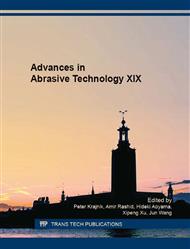[1]
L.R. Ma, C.H. Zhang, J.B. Luo, Investigation of the film formation mechanism of oil-in-water (O/W) emulsions, Soft Matter. 7 (2011) 4207-13.
DOI: 10.1039/c0sm01561j
Google Scholar
[2]
L.R. Ma, X.F. Xu, C.H. Zhang, D. Guo, J.B. Luo, Reemulsification effect on the film formation of O/W emulsion, J Colloid Interf Sci. 417 (2014) 238-43.
DOI: 10.1016/j.jcis.2013.11.073
Google Scholar
[3]
L.R. Ma, J.B. Luo, C.H. Zhang, S.H. Liu, X.C. Lu, D. Guo, et al., Film forming characteristics of oil-in-water emulsion with super-low oil concentration, Colloid Surface A. 340 (2009) 70-6.
DOI: 10.1016/j.colsurfa.2009.03.006
Google Scholar
[4]
S.R. Schmid, W.R.D. Wilson, Lubrication mechanisms for oil-in-water emulsions, Lubr Eng. 52 (1996) 168-75.
Google Scholar
[5]
L. Ma, C. Zhang, J. Luo, Investigation of the film formation mechanism of oil-in-water (O/W) emulsions, Soft Matter. 7 (2011) 4207-13.
DOI: 10.1039/c0sm01561j
Google Scholar
[6]
M. Krzyzanowski, J.H. Beynon, Modelling the behaviour of oxide scale in hot rolling, ISIJ Int. 46 (2006) 1533-47.
DOI: 10.2355/isijinternational.46.1533
Google Scholar
[7]
Y.L. Ma, J.L. Sun, Y. Gao, N.T. li, Lubrication mechanism and effects in hot-strip rolling process, J Univ Sci Technol B. 33 (2011) 178-81.
Google Scholar
[8]
A. Azushima, W.D. Xue, Y. Yoshida, Lubrication mechanism in hot rolling by newly developed simulation testing machine, Cirp Ann-Manuf Techn. 56 (2007) 297-300.
DOI: 10.1016/j.cirp.2007.05.069
Google Scholar
[9]
A. Azushima, W.D. Xue, Y. Yoshida, Influence of lubricant factors on coefficient of friction and clarification of lubrication mechanism in hot rolling, Tetsu to Hagane. 93 (2007) 681-6.
DOI: 10.2355/tetsutohagane.93.681
Google Scholar
[10]
A.A. Keller, H. Wang, D. Zhou, H.S. Lenihan, G. Cherr, B.J. Cardinale, et al., Stability and aggregation of metal oxide nanoparticles in natural aqueous matrices, Environmental science & technology. 44 (2010) 1962-7.
DOI: 10.1021/es902987d
Google Scholar
[11]
M.W. Shen, J.B. Luo, S.Z. Wen, The tribological properties of oils added with diamond nano-particles, Tribol T. 44 (2001) 494-8.
DOI: 10.1080/10402000108982487
Google Scholar
[12]
J.B. Luo, S.Z. Wen, P. Huang, Thin film lubrication . 1. Study on the transition between EHL and thin film lubrication using a relative optical interference intensity technique, Wear. 194 (1996) 107-15.
DOI: 10.1016/0043-1648(95)06799-x
Google Scholar
[13]
J.B. Luo, S.Z. Wen, Mechanism and characters of thin film lubrication at nanometer scale, Science in China Series a-Mathematics Physics Astronomy. 39 (1996) 1312-22.
Google Scholar
[14]
I. Lahouij, F. Dassenoy, L. de Knoop, J.M. Martin, B. Vacher, In situ TEM observation of the behavior of an individual fullerene-like MoS2 nanoparticle in a dynamic contact, Tribol Lett. 42 (2011) 133-40.
DOI: 10.1007/s11249-011-9755-0
Google Scholar
[15]
K. Lee, Y. Hwang, S. Cheong, Y. Choi, L. Kwon, J. Lee, et al., Understanding the role of nanoparticles in nano-oil lubrication, Tribol Lett. 35 (2009) 127-31.
DOI: 10.1007/s11249-009-9441-7
Google Scholar
[16]
L. Rapoport, M. Lvovsky, I. Lapsker, W. Leshchinsky, Y. Volovik, Y. Feldman, et al., Friction and wear of bronze powder composites including fullerene-like WS2 nanoparticles, Wear. 249 (2001) 150-7.
DOI: 10.1016/s0043-1648(01)00519-1
Google Scholar
[17]
T. Xu, J.Z. Zhao, K. Xu, The ball-bearing effect of diamond nanoparticles as an oil additive, J Phys D Appl Phys. 29 (1996) 2932-7.
Google Scholar
[18]
G. Liu, X. Li, B. Qin, D. Xing, Y. Guo, R. Fan, Investigation of the mending effect and mechanism of copper nano-particles on a tribologically stressed surface, Tribol Lett. 17 (2004) 961-6.
DOI: 10.1007/s11249-004-8109-6
Google Scholar


